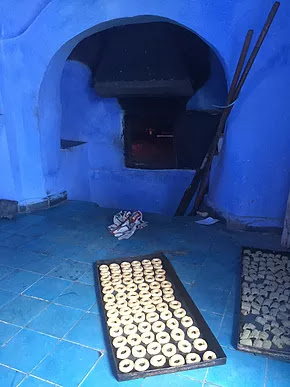We arrived in Chefchaouen after driving through a beautiful valley filled with olive and fig trees. Ramadan was coming to an end and locals were already traveling to see their families; their cars filled with fruits purchased at the roadside vendors. The abundance of fruits and vegetables was wonderful. We often stopped upon seeing locals selling fruits right in front of their farm, and with the help from our wonderful driver Redouane, bought bunches of freshly picked plums and cherries.
We learned that Chefchaouen is often abbreviated as “Chaouen”. We saw so many pictures of this town before the trip and we were looking forward to seeing streets painted in every shade of blue. We arrived in the early evening and as we were walking to our hotel, we could smell and hear the dinner preparations coming from the houses.
Once checked into to our hotel, we went to the rooftop terrace to see the view of the town. It was the time to break the fast and muezzin started chanting from the mosque right next to our hotel. People had dinner tables ready at their terraces and it was wonderful to witness locals breaking fast.
The next morning, we met our local guide and explored the town; narrow streets, keyhole doors, mosques, lamp posts, everything was painted in every shade of blue. It was a small mountain town and very laid back compared to Marrakech and Fez. Together with our guide, we explored the small medina, Kasbah and Ras-el Maa (head of the water) where local women gather by the stream to do laundry.
Tucked away in Africa’s northernmost mountain range, the Rif Mountains, Chefchaouen was founded in 1471 by Moulay Ali Ben Moussa Ben Rached El Alami, it served as a Moorish fortress for exiles from Spain. Over the centuries, the city grew and welcomed Jews and Christian converts alike.
Chefchaouen's powder-blue buildings mirror the cloudless Moroccan sky - but religious rather than stylistic reasons are behind the design choice. Jewish teachings suggest that by dyeing thread with tekhelel (an ancient natural dye) and weaving it into prayer shawls, people would be reminded of God’s power. The memory of this tradition lives on in the regularly repainted blue buildings.
Our guide stopped at a communal bakery where locals bring cookies to be baked. They pay a nominal fee to have these baked in a wooden oven. The baker offered us some and they were delicious. These were special cookies baked for Ramadan.

That evening was the end of Ramadan and the streets were very lively; kids running around, people doing last minute shopping. In the morning of Eid (end of Ramadan) locals wear new clothing and celebrate by offering sweets and cookies.




No comments:
Post a Comment